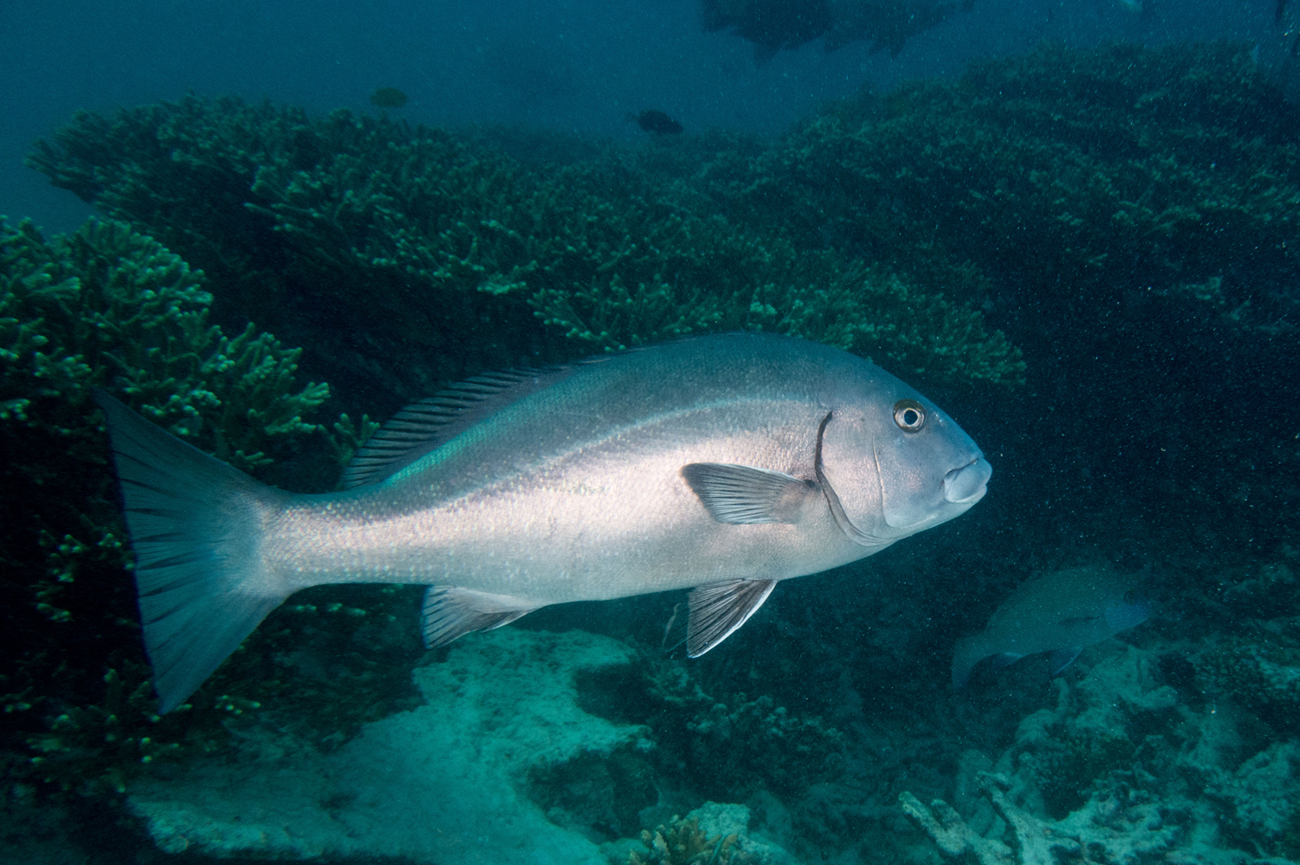- Classification
- ACTINOPTERYGII
- PERCIFORMES
- HAEMULIDAE
- Plectorhinchus
- caeruleonothus
Blue Bastard, Plectorhinchus caeruleonothus Johnson & Worthington Wilmer 2015

A Blue Bastard, Plectorhinchus caeruleonothus, on Ningaloo Reef, Western Australia, July 2017. Source: John Turnbull / Flickr. License: CC by Attribution-NonCommercial-ShareAlike
Summary:
A uniformly silvery-grey sweetlip with the cheek, gill cover and rear margin of the opercular membrane uniformly bluish-grey, the rim of the eye and top edge of upper jaw dusky yellow, and the rear margin of the gill membrane silvery-grey.
Juveniles are a dark chocolate-brown, with about 10 irregular narrow white stripes along the head and body, many oblique white stripes on the tail that converge towards the central margin, and yellow pectoral fins with a central dark brown blotch on the inner fin base.
Juveniles are a dark chocolate-brown, with about 10 irregular narrow white stripes along the head and body, many oblique white stripes on the tail that converge towards the central margin, and yellow pectoral fins with a central dark brown blotch on the inner fin base.
Cite this page as:
Bray, D.J. 2020, Plectorhinchus caeruleonothus in Fishes of Australia, accessed 02 Jul 2025, https://fishesofaustralia.net.au/Home/species/462
Blue Bastard, Plectorhinchus caeruleonothus Johnson & Worthington Wilmer 2015
More Info
|
Distribution |
Known from Rottnest Island, Western Australia, to Lizard Island, Queensland. Inhabits sandy, rubble and reef areas in the intertidal zone, or on shallow reefs, in depths to 30 m. |
|
Features |
Dorsal fin XII, 18–20 (rarely 20); Anal fin III, 6-7 (rarely III, 6); Pectoral fin 16-17; Gill rakers 7–9 (upper limb) + 18–20 (lower limb) of the first arch; Lateral-line scales 56–61;Transverse scale rows above Llat 15. Pelvic fins reaching anus in juveniles, slightly short of anus in adults; nostrils minute, 0.4–0.8 % SL, 2–3 times in distance from posterior nostril to eye. |
|
Colour |
Adults uniformly silver-grey, cheek and opercles blue-grey, rim of orbit and dorsal edge of maxilla dusky yellow, and posterior margin of opercular membrane silver-grey, non-contrasting with remainder of opercle and adjacent body. Juveniles are dark chocolate-brown, with about 10 irregular narrow white stripes along head and body. Stripes on head, including curved one below eye, aligned similarly to those described above, but slightly broader and more well-defined. Numerous oblique white stripes on dark brown background on caudal fin, stripes converging toward centre of rear margin of the fin. Pectoral fins yellow, inner fin base with central dark brown blotch. |
|
Fisheries |
Caught by recreational anglers, and occasionally taken as by-catch in commercial trawls. |
|
Remarks |
While most sweetlips are relatively gregarious and peaceful among their own species, the Blue Bastard reacts aggressively towards members of the same species. Individuals have been seen engaging in one-on-one conflicts, including coming together, locking jaws, and engaging in prolonged and violent struggles near the surface. |
|
Similar Species |
This species is unique among species of Plectorhinchus in having a combination of dorsal-fin rays XII, 18–20, lateral-line scales 56–61, gill rakers 7–9 on the upper limb and 18–20 on the lower limb of the first arch, nostrils minute, and fresh colouration in adults including body uniformly grey, cheek, opercles and posterior margin of the opercular membrane uniformly blue-grey, and rim of orbit and upper edge of maxilla dusky yellow. Juveniles differ from other closely-related species in having a distinctive pattern of narrow creamish-white to pale grey stripes on a dark grey to chocolate brown background on the head and body, and oblique dark stripes progressing with growth to spots on the caudal fin. |
|
Etymology |
The specific name caeruleonothus is from the Latin caeruleo (= blue) and nothus (= bastard). 'Blue Bastard’ has been the name commonly applied to this species by anglers for many years, so given for its blue sheen in life and difficulty to hook and land on artificial fly. |
|
Species Citation |
Plectorhinchus caeruleonothus Johnson & Worthington Wilmer 2015, Zootaxa 3985(4): 498, Figs 2-5. Type locality: Boyd Bay, SW of Weipa, Queensland, Australia, 12°54.9'S, 141°38.6"E, depth 0.5-3 m. |
|
Author |
Bray, D.J. 2020 |
|
Resources |
Blue Bastard, Plectorhinchus caeruleonothus Johnson & Worthington Wilmer 2015
References
Johnson, J.W. & Worthington Wilmer, J. 2015. Plectorhinchus caeruleonothus, a new species of sweetlips (Perciformes: Haemulidae) from northern Australia and the resurrection of P. unicolor (Macleay, 1883), species previously confused with P. schotaf (Forsskål, 1775). Zootaxa 3985(4): 491-522. https://doi.org/10.11646/zootaxa.3985.4.2








